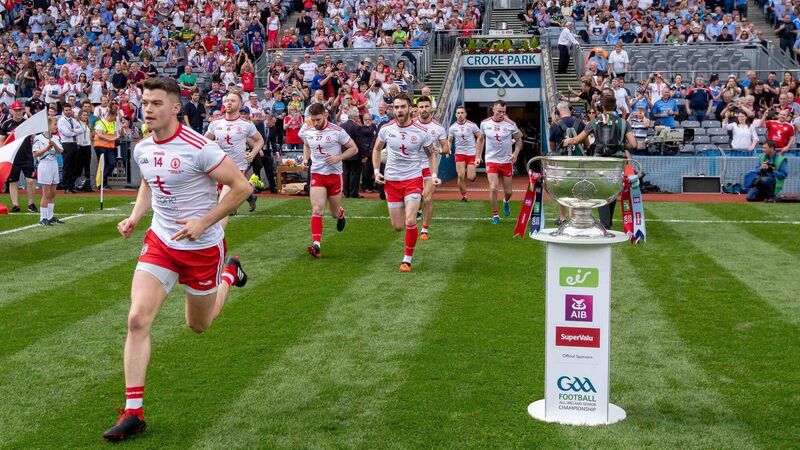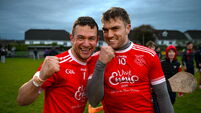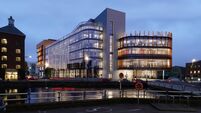The Tyrone question: Inside the team, the people who are so hungry to upset the consensus

AT ONE: Tyrone's finest take to the field at Croke Park. Picture: Morgan Treacy, Inpho
Think of the statement wins. Kerry in 2003. Armagh in the All-Ireland semi-final of 2005. Dublin in the 2008 quarter-final, Kerry a few weeks later in the final. The semi-final of a fortnight back.
What ties them all together? The fact that they were given no chance whatsoever.
Consider the times they stumbled. The drawn Ulster final of 2003 when they leaked goals under the high ball. The qualifier defeat to Laois in 2006. Mayo in 2004. Days when Tyrone were purring along, expected to take a gentle step into the next round.
Has any team, any people, been so hungry to upset the consensus? Back when they were making their 2003 breakthrough they could take their pick of motivational morsels. Colm O’Rourke said he would eat his hat if a Tyrone team with Brian Dooher won an All-Ireland. Pat Spillane called their style "puke football". Why does this negativity work so well for Tyrone?
Does it plays to something deep within the collective consciousness? A sense of having been wronged and disenfranchised. Do they play with the edge of the dispossessed?
If they seem like they play as if driven by a historical hurt, then that makes perfect sense.
Dr Jim O’Neill, author of ‘The Nine Years War 1593 — 1603,’ is an expert on the long and bloody battle between the Irish alliance of Hugh O’Neill of Tyrone and Hugh Roe O’Donnell of Tir Chonaill, against the British forces brought in by the Tudor invasion.
While battles were fought all over Ireland, the most significant ones were fought in Ulster.
The area of Tyrone at the time stretched into modern day Donegal, Derry, and Armagh. Robert Cecil, the 1st Earl of Salisbury was the principal political guide for Queen Elizabeth during that time. He had a map drawn up of Ireland marking places of military and economic interest.
“And Dungannon was on that map,” states O’Neill. “There were goods coming in from the Balkans, gunpowder and munitions coming in for the war. There were Scottish and European merchants staying in Dungannon at the time because the English reported on it.
“The major players in Europe knew what was happening. They knew about places here. Philip the Second in Spain, Philip the Third in Spain knew of Tyrone, of Dungannon and other places here.
“Queen Elizabeth was tortured by Tyrone. The War that O’Neill started, the Nine Year War, took more money off the Crown that any other operation outside the Spanish Armada. There was no war that Elizabeth fought that cost more and it almost bankrupted the Crown.
Mark Conway of Club Tyrone, the county’s fundraising wing for Gaelic Games activities, has a special interest and connection with that period of history.
“Gaelic Ulster was the last bastion of Gaelic Ireland. I suppose Gaelic Tyrone was the last bastion of Gaelic Ulster. It was the last to fall, but some would say it never really fell,” he notes.
“The thing about the Nine Year War, that would have hit deep. Hugh O’Neill and those boys who left in the Flight of the Earls and a new regime came into play. Then you had the next rising a generation later, the Battle of Benburb, Eoghan Ruadh O’Neill and all that.
“Tyrone, the nature of the place it never let go of that old Gaelic tradition.”
When the boat left Rathmullan with Hugh O’Neill and 90 of his followers, bound for mainland Europe and the exile of the Flight of the Earls, it cleared the way for the Plantation of Ulster.
Wind the tape on a few hundred years to the 1910s, as various border commissions are debating the possibility of a British border dissecting Ulster.
Tyrone, like south Armagh and Fermanagh, would never have dreamt they could have been left inside any partition.
While a World War was going on outside the gates of a Buckingham Palace conference on July 21, 1914, leaders of Irish nationalism and unionism were inside fighting their cases. Presiding over it, letting the play flow in the manner of a Joe McQuillan, was Prime Minister Herbert Asquith.
The following day, he recorded his feelings: “We sat again for an hour and a half discussing maps and figures and always getting back to that most damnable creation of the perverted ingenuity of man — the County of Tyrone.”
Neither side could afford to let it go, all the while not getting what made it so attractive to the other side.
After the border was drawn up, Tyrone nationalism was abandoned. Those that had seen enough fighting and had no stomach for more were left utterly demoralised.
Here they were, left in a new state. One they could not relate to. With votes gerrymandered to ensure deprivation and power kept out of reach. There was no definitive moment or a call to action, but northern nationalists began making the most of things.
“The mentality was ‘this is the way it is going to be now. This is not user-friendly for us, but we will build a state within a state. With our Catholic schools and the GAA and everything else we will put into place. The credit unions and so on,’” Conway explains.
Since their first Ulster title in 1956, no Ulster county have won the Ulster title as many times as Tyrone. The ‘60s and ‘70s were dismal decades with just the one title in 1973. The Troubles impacted on the sporting aspirations of young men and emigration was a good alternative as a new Flight had young men from the county hanging off scaffolding towers in London, New York and, in particular, Philadelphia.
That American connection can also be seen in the highest offices. Former Presidents James Buchanan, Ulysses S Grant, Woodrow Wilson, and Harry Truman all had Tyrone lineage.
In other areas of its development, Tyrone remained resolutely apart.
Consider the literature and writers from the county, a significant proportion of Presbyterian stock in WF Marshall, William Carleton, along with John Montague, Brian Friel, Benedict Kiely, and Flann O’Brien.
All unique and uncompromising. Some favouring the dialect more than others, such as Marshall’s ‘Living in Drumlister’ with lines such as ‘But I’m livin’ in Drumlister / In clabber to the knee.’ That tradition continues to the present-day practitioners such as the surrealist comedy of Kevin McAleer.
There’s also something resolutely ‘Tyrone’ in the uncompromising style of Mark McCausland, one half of the beguiling ‘Lost Brothers’, and Juliet Turner, another musician labelled ‘difficult’ by some because she refuses to be packaged and presented in a way not of her own choosing.
Physically, it is a stunning place, particularly in the west. Around the Sperrin Mountains, the Glenelly Valley, stretching down to Carrickmore, Loughmacrory, Greencastle was the area formerly known as ‘Muintir Luinigh.’ It’s only a generation or two ago that native Irish completely died out as a natural language.
And yet it does not feature in the thinking or plans of Government.
“There is that sense that the county is not… not neglected as such, but under-served,” says Dr Dónal McAnallen, a historian who has written extensively on the county and on GAA.
“No railways, and we are not unique in that of course, but we are the centre of Ulster and you go through it to go to many parts of the north-west.
“There is no proper hospital now worth talking about now. We have about three kilometres of motorway. Any tourism campaign will focus on the other five counties, it will not focus on Tyrone. And yet Tyrone has plenty of its own charms.”
But there’s one main charm for him of course. At 42, he is still playing club football with Eglish St Patrick’s, whom he lined out with alongside his late brother and former county captain Cormac.
Dónal wasn’t good enough to play county football. But he stuck at it long enough to pull on the white jersey and play Masters football this season alongside 2005 Footballer of the Year, Stephen O’Neill.
“There’s something about the Red Hand that has an allure,” he admits.
As strong as that draw is, it is built on a club scene that has two extreme sides; tremendous, one-eyed total devotion to your club that frequently crosses into almost psychotic behaviour. Club league games here at any level can be played with an intensity that neighbouring counties could never even hope for in their domestic Championships.
One of the greatest driving forces within the GAA is good old-fashioned jealousy of the crowd over in the next parish. A couple of decades of almost competitive premises-building fed into ambitions being raised ever higher.
“People like me always say, ‘what is the GAA about?’ And it’s not about games at all. It’s about ‘who you are’, and ‘where you’re from,’” says Conway.
“Where it gets dangerous, in answering that, you think, ‘I’m so and so, and because I am so-and-so, I am better than everybody else and I’m superior.’ You get into dangerous territory then when people start to think like that.
“But if you don’t go that far, if you have pride and contentment in your own place and your own people and your own community, it is very powerful.
“In Tyrone, we have a fair balance. It’s not perfect, but we have a fair balance.”
The injustice of the 1995 final was turned into an inferno after the way they were treated in the following year’s semi-final when Meath literally and figuratively walked over them.
It was at that point that they decided to do something about it.
Tyrone was now full of men and women who hadn’t needed to get a plane ticket or a ferry just to secure work. The population had enough educated and highly-motivated people, some of whom benefitted from greater ease of university education, others who didn’t allow their lack of it inhibit their ambition or abilities.
It coincided with an industrial revolution within the county, mainly in engineering with the establishment of firms such as Terex Finlay, Powerscreen, Mallaghan, and more recently, current jersey sponsors Tyrone Fabrication, founded in 1992.
Around the same time, Mickey Harte was starting his management career with Tyrone minors, laying the foundation stones of his great team that could come a decade later.
While he created his own alchemy, everything else was falling into place. Gaelic football had established itself as the dominant form of cultural expression for the past couple of decades. Club Tyrone were already making plans for a state-of-the-art training complex that would be built in Garvaghey, alongside the homeplace of John Montague.
The establishment took on a different form. No Elizabethan Rule now, but tut-tutting from the newspaper columnists and television pundits. Tyrone turned it into something else.
Sports psychologist Dr John Kremer has worked with Tyrone teams down through the years and recognised that they needed to be in that space. To nurture all those elements that others might dismiss as petty grievances.
“I would agree in terms of that Tyrone psyche, it is something about having something to prove and ‘against all odds,’” he says.
“All of those things come into play. It’s not necessarily a comfortable place to be in terms of sports psychologist looking at things but it can give that edge. It’s an interesting one, because it is one that is never fully satisfied.”
For Tyrone, it’s never enough.














